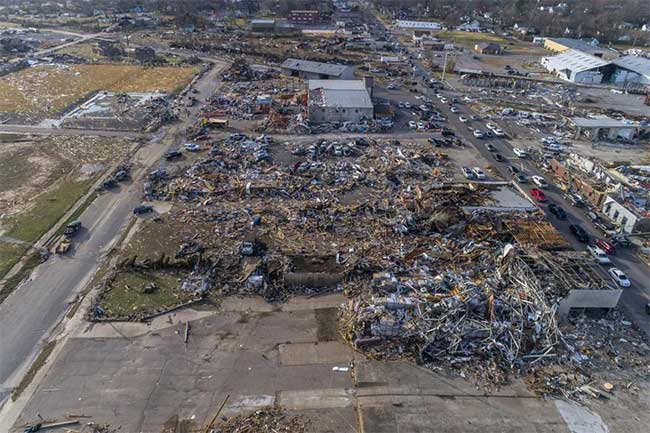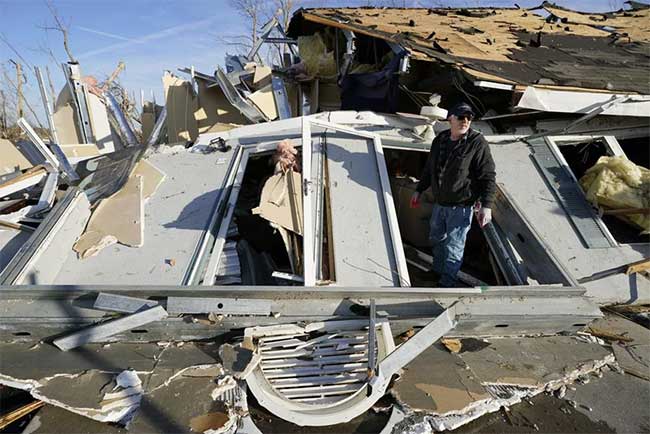Historical tornadoes in the United States primarily occur due to weather conditions. However, scientists are researching to better understand the connection between climate change and tornadoes.
In the U.S., tornadoes are generally rare in December, but that doesn’t mean they can’t happen. The tornado outbreak last weekend is a prime example. Dozens of tornadoes swept across the Midwest and Southern states, potentially resulting in around 100 fatalities.
“It’s astonishing and hard to believe,” said Professor Victor Gensini, a meteorologist at Northern Illinois University, to AP.
Weather factors, including temperature, humidity, and the La Niña phenomenon, were direct causes of this historic tornado outbreak. Meanwhile, scientists are investigating whether climate change is making tornadoes more dangerous.
How Are Tornadoes Formed?
Tornadoes are vertical columns of air that spin from the sky down to the ground. Formed from thunderstorms, they move at high speeds and can destroy anything in their path.
Tornadoes are generated when heavier, drier, and colder air aloft exerts pressure on warmer, moister air below, causing instability in the atmosphere. At this point, the warm air underneath begins to rise. Due to wind effects, the air mass starts to rotate.

The town of Mayfield, Kentucky, after being hit by the tornado. Mayfield was the hardest-hit location during the tornado on December 10. (Photo: AP).
As wind speed and direction change, the air mass gains enough rotation to become a tornado. “That’s exactly what happened last weekend,” said Professor Paul Markowski, a meteorologist at Penn State University.
Differences in wind direction and speed at higher altitudes are particularly noticeable in winter due to temperature and air pressure differences.
However, winter air is usually more stable. Therefore, tornadoes typically occur in spring when the air is warm and moist.
The United States is the country most affected by tornadoes in the world. On average, the country experiences about 1,200 tornadoes each year, according to the National Oceanic and Atmospheric Administration (NOAA).
Why Was the Recent Tornado So Devastating?
This December, the weather in the Midwest and Southern U.S. resembled spring conditions. Temperatures and humidity levels remained high. Warm and moist air made the atmosphere unstable, creating conditions for strong tornadoes to form.
The La Niña phenomenon also plays a part in this. However, scientists warn that warmer winters will occur more frequently as the Earth warms.
“The worst-case scenario has occurred. It’s warm air in the cold season, especially in the middle of the night,” said John Gordon, a meteorologist with the National Weather Service in Louisville, Kentucky.
Typically, tornadoes dissipate as the thunderstorm above weakens. This process usually occurs within minutes. However, when wind conditions at higher altitudes differ significantly, tornadoes gain energy and continue to exist.
The tornadoes on December 10 lasted for several hours.
One tornado traveled approximately 322 kilometers, nearly breaking the record of 352 kilometers set in 1925.
“For a tornado to have such length, it must move at very high speeds. This tornado exceeded 80 km/h for most of its existence,” Professor Gensini noted. “This is the ‘high-speed’ movement of a storm.”

A man in Mayfield stands next to a destroyed house. (Photo: AP).
How Does Climate Change Affect Tornadoes?
The relationship between climate change and tornadoes in the U.S. is still a subject of research for scientists. This is not an easy task, as the consequences of climate change often have opposing effects. Additionally, only about 10% of large thunderstorms produce tornadoes, making comparisons more challenging.
However, American scientists have observed that thunderstorms are changing as the Earth warms. According to Professor Gensini, the frequency of severe thunderstorms is increasing. Warmer winter air is making this type of weather more likely.
In agreement, Harold Brooks, a tornado researcher at the National Severe Storms Laboratory, stated that the U.S. may witness more tornadoes in winter as temperatures trend upward.
Conversely, he noted that the frequency of summer storms is likely to decrease.
According to Professor Jason Furtado at the University of Oklahoma, the areas where large tornadoes typically occur are shifting eastward, towards the Mississippi River Valley. This phenomenon is caused by changes in temperature, humidity, and wind patterns.
“Residents in the Mississippi and Ohio River valleys will face more storms in the future,” he said.


















































